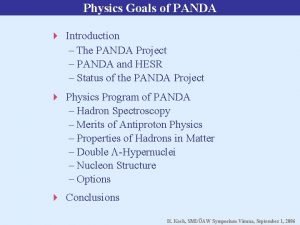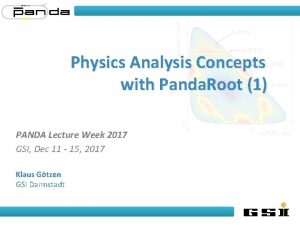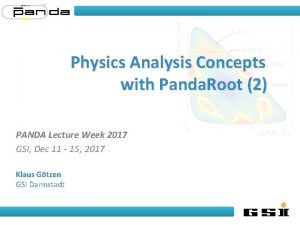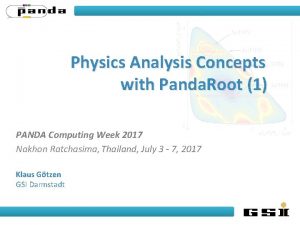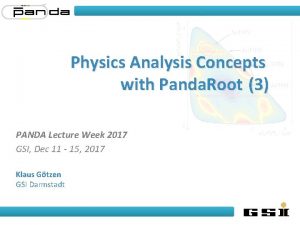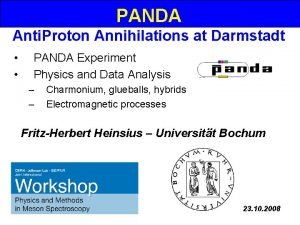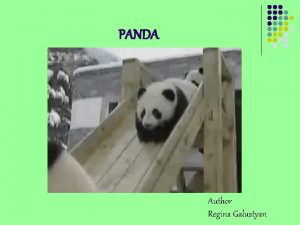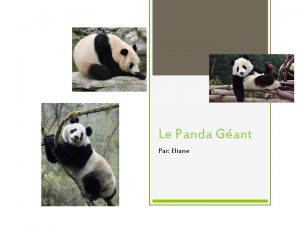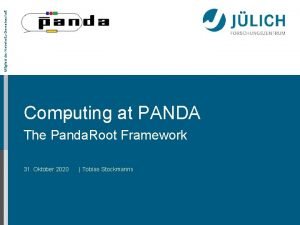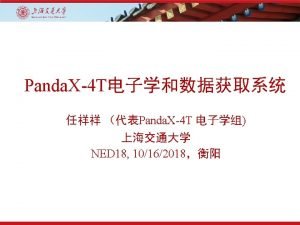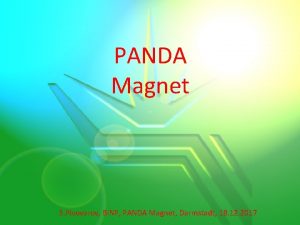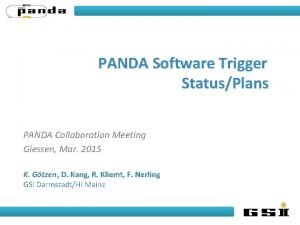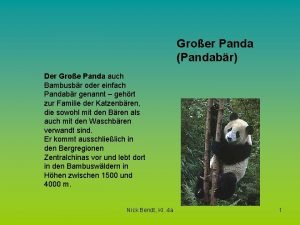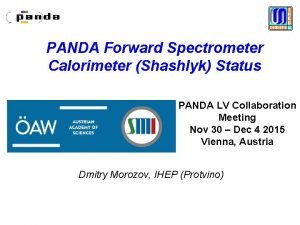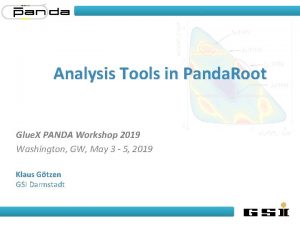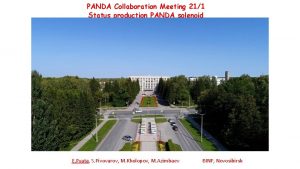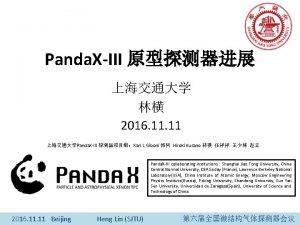Physics Goals of PANDA Introduction The PANDA Project



































- Slides: 35

Physics Goals of PANDA Introduction – The PANDA Project – PANDA and HESR – Status of the PANDA Project Physics Program of PANDA – Hadron Spectroscopy – Merits of Antiproton Physics – Properties of Hadrons in Matter – Double -Hypernuclei – Nucleon Structure – Options Conclusions H. Koch, SMI/ÖAW Symposium Vienna, September 1, 2006

The PANDA Project Study pp-reactions (Fixed target) in the p-momentum range from 1. 5 - 15 Ge. V/c, Fixed energy / Beam scan mode Targets: Hydrogen (unpolarized), Nuclear Targets Typical reactions: Hadron Spectroscopy up to the Charm-Region (Conventional qq and exotic states) Nucleon Structure Properties of Hadrons in Matter Double -Hypernuclei H. Koch, SMI/ÖAW Symposium Vienna, September 1, 2006

The PANDA Detector (1) Detector requirements • • • full angular acceptance and angular resolution for charged particles and , 0 particle identification ( , K , e, ) in the range up to ~ 8 Ge. V/c high momentum resolution in a wide energy range high rate capabilities, especially in interaction point region and forward detector : expected interaction rate ~ 107/s precise vertex reconstruction for fast decaying particles H. Koch, SMI/ÖAW Symposium Vienna, September 1, 2006

The PANDA Detector (2) H. Koch, SMI/ÖAW Symposium Vienna, September 1, 2006

PANDA and HESR High Energy Storage Ring (HESR), proposed by P. K. Circumference 574 m Momentum (energy) range 1. 5 to 15 Ge. V/c (0. 8 -14. 1 Ge. V) Injection of (anti-)protons from RESR at 3. 8 Ge. V/c Acceleration rate 0. 1 Ge. V/c/s Electron cooling up to 8. 9 Ge. V/c (4. 5 Me. V electron cooler) Stochastic cooling above 3. 8 Ge. V/c H. Koch, SMI/ÖAW Symposium Vienna, September 1, 2006

HESR: Parameters Experiment Mode Momentum range High Resolution Mode High Luminosity Mode 1. 5 – 8. 9 Ge. V/c 1. 5 – 15. 0 Ge. V/c Target Pellet target with 4*1015 cm-2 Number of stored Antiprotons 1*1010 1*1011 2*1031 cm-2 s-1 2*1032 cm-2 s-1 Luminosity rms-emittance rms-momentum resolution 1 mm mrad 10 -5 10 -4 H. Koch, SMI/ÖAW Symposium Vienna, September 1, 2006

HESR at FAIR Facility for Antiproton and Ion Research HESR High Energy Storage Ring Antiproton Physics at high Energies H. Koch, SMI/ÖAW Symposium Vienna, September 1, 2006

Status of the PANDA Project (1) H. Koch, SMI/ÖAW Symposium Vienna, September 1, 2006

Status of the PANDA Project (2) Example: Simulation of the PANDA interaction region with NEG-coated beam pipes at SMI H. Koch, SMI/ÖAW Symposium Vienna, September 1, 2006

Status of the PANDA Project (3) Example: E. -M. Calorimeter (Pb WO 4/PWO) Requirements: Fast Response Good energy resolution, even at low energies Development of new crystals PWO (CMS) PWO II Better material Increase of light yield ≈ 100% Operation of crystals at – 25°C Reduction of thermal quenching Increase of light yield by ≈ 400% Best PWO energy resolution, ever measured Development of Large Area APD‘s (together with Hamamatsu Photonics) Signals comparable to Photo-Multiplier Readout Operation in high magnetic fields H. Koch, SMI/ÖAW Symposium Vienna, September 1, 2006

PANDA – Hadron Spectroscopy Program (1) H. Koch, SMI/ÖAW Symposium Vienna, September 1, 2006

PANDA – Hadron Spectroscopy Program (2) Charmonium Spectroscopy (Many Inputs from P. K. ) H. Koch, SMI/ÖAW Symposium Vienna, September 1, 2006

PANDA – Hadron Spectroscopy Program (3) Experiments cc : c (11 S 0) experimental error on M > 1 Me. V hard to understand in simple quark models c’ (21 S 0) Recently seen by Belle, Ba. Bar, Cleo Crystal Ball result way off hc(1 P 1) Spin dependence of QQ potential Compare to triplet P-States LQCD NRQCD States above the DD threshold Higher vector states not confirmed (3 S), (4 S) 1 st radial excitation of P wave states Narrow D wave states, only (3770) seen Sensitive to long range Spin-dependent potential Nature of the new X(3872), X(3940), Y(3940) and Z(3940) H. Koch, SMI/ÖAW Symposium Vienna, September 1, 2006

PANDA – Hadron Spectroscopy Program (4) Charmonium Hybrids predicted in various QCD models (LQCD, bag models, flux tubes. . . ) Some charmonium hybrids predicted to be narrow (exotic quantum numbers) Production cross section similar to other charmonia (~150 pb) H. Koch, SMI/ÖAW Symposium Vienna, September 1, 2006

PANDA – Hadron Spectroscopy Program (5) Charmonium Hybrids Decay modes: J/ ; D*D Exotic light qqg 1 10 -2 0 2000 Exotic ccg 1 -- 1 -+ Small overlap with cc-states 102 4000 2 Me. V/c 42] K. Juge, J. Kuti, and C. Morningstar, Phys. Rev. Lett. 90, 161601 (2003). H. Koch, SMI/ÖAW Symposium Vienna, September 1, 2006

PANDA – Hadron Spectroscopy Program (6) Glueballs (gg) Predictions: Masses: 1. 5 -5. 0 Ge. V/c 2 (Ground state found? ; Candidates for further states? ) Quantum numbers: Several spin exotics (oddballs), e. g. JPC = 2+- (4. 3 Ge. V/c 2 ) Widths: ≥ 100 Me. V/c 2 – Decay into two lighter glueballs often forbidden because of q. -n. – No mixing effects for oddballs Decays: , , H. Koch, SMI/ÖAW Symposium Vienna, September 1, 2006

PANDA – Hadron Spectroscopy Program (7) Open Charm States New observations The DS± spectrum |cs> + c. c. was not expected to reveal any surprises, but. . . – Potential model – Old measurements – New observations (Ba. Bar, CLEO-c, Belle) Or these are molecules ? Most recent state (Ba. Bar): Ds. J(2680)+ D 0 K+ * Ds 0 (2317) Ds 1 (2458) H. Koch, SMI/ÖAW Symposium Vienna, September 1, 2006

Merits of Antiprotons (1) In pp-annihilation all mesons can be formed Example: pp 1, 2 J/ e+e– In contrast: In e+e–-annihilation only JPC = 1 -- can be formed e+e– J/ , e+e– 1, 2 Resolution of the mass and width is only limited by the (excellent) beam momentum resolution Resonance cross section Measured rate Beam CM Energy H. Koch, SMI/ÖAW Symposium Vienna, September 1, 2006

Merits of Antiprotons (2) p-beams can be cooled Excellent beam momentum resolution H. Koch, SMI/ÖAW Symposium Vienna, September 1, 2006

Merits of Antiprotons (3) Crystal Ball: typical resolution ~ 10 Me. V Fermilab: 240 ke. V PANDA: ~20 ke. V p/p ~ 10 -5 needed H. Koch, SMI/ÖAW Symposium Vienna, September 1, 2006

Merits of Antiprotons (4) pp-cross sections high Data with very high statistics Example: pp 0 0 0 (LEAR) f 0(1500) = best candidate for Glueball ground state Low final state multiplicities: Clean spectra, Good for PWA analyses H. Koch, SMI/ÖAW Symposium Vienna, September 1, 2006

Merits of Antiprotons (5) High probability for production of exotic states ^ Example: pp 0 0 : (1400) (JPC = 1–+) = candidate for Hybrid ground state H. Koch, SMI/ÖAW Symposium Vienna, September 1, 2006

Properties of Hadrons in Matter (1) t ~ 10… 20 fm/c _ p final state = e+e- / m+m- / gg / J/y g ~ 1 fm p´s interact with p within 1 fm At appropiate ECM(pp) J/y, y´, cc –systems are formed (b ≈ 0. 8 - 0. 9) Effects to be considered: Ø Fermi motion of nucleons (≈ 200 Me. V) Ø Collisional broadening of states (≈ 20 Me. V) } Trivial } Ø Mass shifts and broadening of cc-states in matter Ø Mass shifts and modifications of spectral functions of open charm states (D±) Chiral dynamics, Partial restoration of chiral symmetry in hadronic environment P. K. , see also talks of T. Yamazaki and N. Herrmann H. Koch, SMI/ÖAW Symposium Vienna, September 1, 2006

Properties of Hadrons in Matter (2) Predictions: 1) Hidden charm states (cc): Small mass shifts: 10 - 100 Me. V (Gluon Condensate) Sizeable width changes 2) Open charm states (Qq): p- p K 25 Me. V p+ K+ 100 Me. V D KD- 50 Me. V D+ Hayaski, PLB 487 (2000) 96 Morath, Lee, Weise, priv. Comm. Calculation: A. Sibirtsev et al. , Eur. Phys. J A 6 (1999) 351 H. Koch, SMI/ÖAW Symposium Vienna, September 1, 2006

Properties of Hadrons in Matter (3) J/ absorption cross section in nuclear matter p + A J/ + (A– 1) stot (J/ N) Important for QGP H. Koch, SMI/ÖAW Symposium Vienna, September 1, 2006

Double -Hypernuclei (1) Hypernuclei open a 3 rd dimension (strangeness) in the nuclear chart Double-hypernuclei: K+K Trigger very little data p _ Baryon-baryon interactions: – 3 Ge. V/c -N only short ranged (no 1 –exchange due to isospin) - impossible in scattering reactions secondary target X-(dss) p(uud) (uds) H. Koch, SMI/ÖAW Symposium Vienna, September 1, 2006

Double -Hypernuclei (2) Current state of the art detection resolution : 2 Ke. V (KEK E 419) Current state of the art p detection resolution : E = 1. 29 Me. V Finuda Collaboration, PLB 622: 35 -44, 2005 Solid state detector (diamond or silicon) compact : thickness ~ 3 cm high rate capability high resolution capillar (2 D) or pixel (3 D) position sensitive Germanium detector (like Vega or Agata) H. Koch, SMI/ÖAW Symposium Vienna, September 1, 2006

Nucleon Structure (1) Annihilation into two Photons: pp Intermediate energies: Dominance of handbag diagram for s ≈ 10 Ge. V 2; |t| ≈ s( ≈90°) Timelike GPD´s Prediction (from pp): ≈ 15 pb ( s = 3. 6 Ge. V) Simulation: Several thousand events/month (|cos |) < 0. 6 Wide Angle Compton Scattering Problem: Background from 0 (420 pb) ; 0 0 (17500 pb) Spacelike GPD´s Related processes: Timelike GPD´s H. Koch, SMI/ÖAW Symposium Vienna, September 1, 2006

Nucleon Structure (2) Annihilation to: or Comparison between predictions and data Check of Factorisation Contribution to Parton Distribution Functions: DY-Dilepton-Production: Boer-Mulders-Function H. Koch, SMI/ÖAW Symposium Vienna, September 1, 2006

Nucleon Structure (3) Timelike Proton Form Factor Present situation: Assumption: |GM|timelike ≈ 2 x. GM spacelike |GE| = |GM| PANDA: Much wider angular acceptance and higher statistics Measure for higher Q 2 Check timelike/spacelike equality Measure |GE| and |GM| separately: 29 Ge. V 2 H. Koch, SMI/ÖAW Symposium Vienna, September 1, 2006

Physics Program / Further Options (1) – Baryon Spectroscopy New states, Quantum numbers and decay rates H. Koch, SMI/ÖAW Symposium Vienna, September 1, 2006

Physics Program / Further Options (2) – Strangeness in Nuclei (Essential input by P. K. ) Use pp-annihilation in nuclei to search for [pp. K–], [ppn. K–], . . . , [p 3 He], . . . , [ (A-1)]-systems – Direct CP-Violation in , -decays Compare angular decay asymmetries Prediction (SM) ≈ 2 x 10 -5 HESR: 1 year of beamtime – CP-Violation in charmed region Direct CP-Violation (SCS) H. Koch, SMI/ÖAW Symposium Vienna, September 1, 2006

Conclusions Enormous impact in particle physics of p-induced reactions have unique features – Nearly all states can be directly produced – High cross sections guarantee high statistics data p-beams can be cooled very effectively The planned p-experiments at FAIR will contribute to a further understanding of the non-perturbative sector of QCD The impact of Paul Kienle to Fair and particularly to the Antiproton Project was enormous as far as physics ideas and technical developments were concerned. Without his constant help and new ideas the project would not have prospered so well. H. Koch, SMI/ÖAW Symposium Vienna, September 1, 2006

Bild Trento H. Koch, SMI/ÖAW Symposium Vienna, September 1, 2006

Lord of Rings H. Koch, SMI/ÖAW Symposium Vienna, September 1, 2006
 Strategic goals tactical goals operational goals
Strategic goals tactical goals operational goals Strategic goals tactical goals operational goals
Strategic goals tactical goals operational goals General goals and specific goals
General goals and specific goals Motivation in consumer behaviour
Motivation in consumer behaviour Panda project ideas
Panda project ideas Why does it happen
Why does it happen University physics with modern physics fifteenth edition
University physics with modern physics fifteenth edition Physics ia format
Physics ia format Hình ảnh bộ gõ cơ thể búng tay
Hình ảnh bộ gõ cơ thể búng tay Slidetodoc
Slidetodoc Bổ thể
Bổ thể Tỉ lệ cơ thể trẻ em
Tỉ lệ cơ thể trẻ em Voi kéo gỗ như thế nào
Voi kéo gỗ như thế nào Glasgow thang điểm
Glasgow thang điểm Bài hát chúa yêu trần thế alleluia
Bài hát chúa yêu trần thế alleluia Các môn thể thao bắt đầu bằng từ đua
Các môn thể thao bắt đầu bằng từ đua Thế nào là hệ số cao nhất
Thế nào là hệ số cao nhất Các châu lục và đại dương trên thế giới
Các châu lục và đại dương trên thế giới Cong thức tính động năng
Cong thức tính động năng Trời xanh đây là của chúng ta thể thơ
Trời xanh đây là của chúng ta thể thơ Cách giải mật thư tọa độ
Cách giải mật thư tọa độ Phép trừ bù
Phép trừ bù độ dài liên kết
độ dài liên kết Các châu lục và đại dương trên thế giới
Các châu lục và đại dương trên thế giới Thơ thất ngôn tứ tuyệt đường luật
Thơ thất ngôn tứ tuyệt đường luật Quá trình desamine hóa có thể tạo ra
Quá trình desamine hóa có thể tạo ra Một số thể thơ truyền thống
Một số thể thơ truyền thống Bàn tay mà dây bẩn
Bàn tay mà dây bẩn Vẽ hình chiếu vuông góc của vật thể sau
Vẽ hình chiếu vuông góc của vật thể sau Nguyên nhân của sự mỏi cơ sinh 8
Nguyên nhân của sự mỏi cơ sinh 8 đặc điểm cơ thể của người tối cổ
đặc điểm cơ thể của người tối cổ Thế nào là giọng cùng tên?
Thế nào là giọng cùng tên? Vẽ hình chiếu đứng bằng cạnh của vật thể
Vẽ hình chiếu đứng bằng cạnh của vật thể Phối cảnh
Phối cảnh Thẻ vin
Thẻ vin đại từ thay thế
đại từ thay thế




